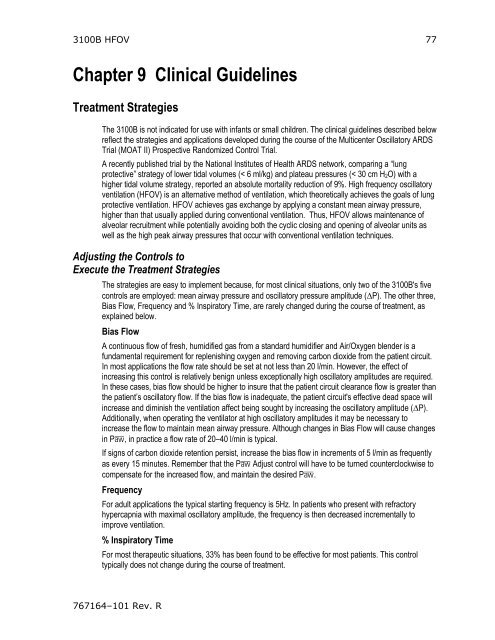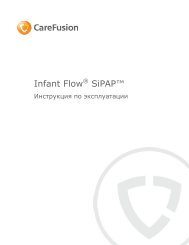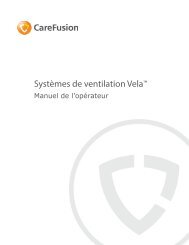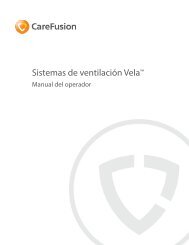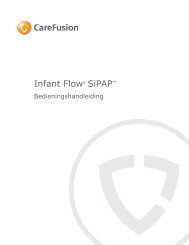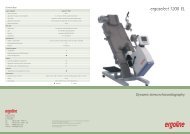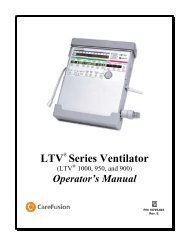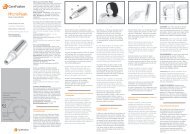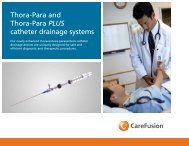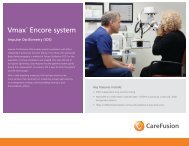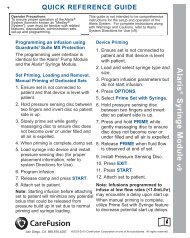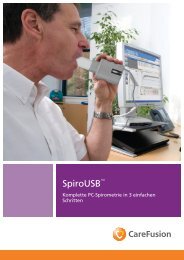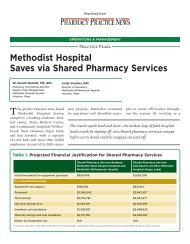3100B HFOV Operator Manual - CareFusion
3100B HFOV Operator Manual - CareFusion
3100B HFOV Operator Manual - CareFusion
You also want an ePaper? Increase the reach of your titles
YUMPU automatically turns print PDFs into web optimized ePapers that Google loves.
<strong>3100B</strong> <strong>HFOV</strong> 77<br />
Chapter 9 Clinical Guidelines<br />
Treatment Strategies<br />
The <strong>3100B</strong> is not indicated for use with infants or small children. The clinical guidelines described below<br />
reflect the strategies and applications developed during the course of the Multicenter Oscillatory ARDS<br />
Trial (MOAT II) Prospective Randomized Control Trial.<br />
A recently published trial by the National Institutes of Health ARDS network, comparing a “lung<br />
protective” strategy of lower tidal volumes (< 6 ml/kg) and plateau pressures (< 30 cm H 2O) with a<br />
higher tidal volume strategy, reported an absolute mortality reduction of 9%. High frequency oscillatory<br />
ventilation (<strong>HFOV</strong>) is an alternative method of ventilation, which theoretically achieves the goals of lung<br />
protective ventilation. <strong>HFOV</strong> achieves gas exchange by applying a constant mean airway pressure,<br />
higher than that usually applied during conventional ventilation. Thus, <strong>HFOV</strong> allows maintenance of<br />
alveolar recruitment while potentially avoiding both the cyclic closing and opening of alveolar units as<br />
well as the high peak airway pressures that occur with conventional ventilation techniques.<br />
Adjusting the Controls to<br />
Execute the Treatment Strategies<br />
The strategies are easy to implement because, for most clinical situations, only two of the <strong>3100B</strong>'s five<br />
controls are employed: mean airway pressure and oscillatory pressure amplitude (∆P). The other three,<br />
Bias Flow, Frequency and % Inspiratory Time, are rarely changed during the course of treatment, as<br />
explained below.<br />
Bias Flow<br />
A continuous flow of fresh, humidified gas from a standard humidifier and Air/Oxygen blender is a<br />
fundamental requirement for replenishing oxygen and removing carbon dioxide from the patient circuit.<br />
In most applications the flow rate should be set at not less than 20 l/min. However, the effect of<br />
increasing this control is relatively benign unless exceptionally high oscillatory amplitudes are required.<br />
In these cases, bias flow should be higher to insure that the patient circuit clearance flow is greater than<br />
the patient’s oscillatory flow. If the bias flow is inadequate, the patient circuit's effective dead space will<br />
increase and diminish the ventilation affect being sought by increasing the oscillatory amplitude (∆P).<br />
Additionally, when operating the ventilator at high oscillatory amplitudes it may be necessary to<br />
increase the flow to maintain mean airway pressure. Although changes in Bias Flow will cause changes<br />
in Pa, in practice a flow rate of 20–40 l/min is typical.<br />
If signs of carbon dioxide retention persist, increase the bias flow in increments of 5 l/min as frequently<br />
as every 15 minutes. Remember that the Pa Adjust control will have to be turned counterclockwise to<br />
compensate for the increased flow, and maintain the desired Pa.<br />
Frequency<br />
For adult applications the typical starting frequency is 5Hz. In patients who present with refractory<br />
hypercapnia with maximal oscillatory amplitude, the frequency is then decreased incrementally to<br />
improve ventilation.<br />
% Inspiratory Time<br />
For most therapeutic situations, 33% has been found to be effective for most patients. This control<br />
typically does not change during the course of treatment.<br />
767164–101 Rev. R


